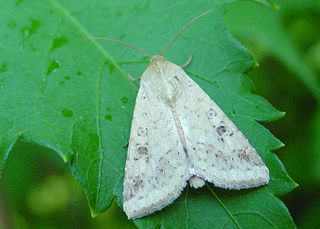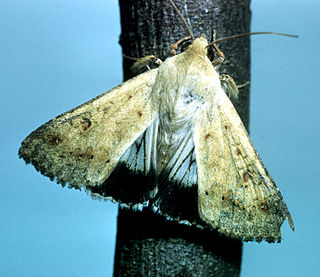
Helicoverpa zea, commonly known as the corn earworm, is a species in the family Noctuidae. The larva of the moth Helicoverpa zea is a major agricultural pest. Since it is polyphagous during the larval stage, the species has been given many different common names, including the cotton bollworm and the tomato fruitworm. It also consumes a wide variety of other crops.
Cotton bollworm is a problem in growing cotton. "A major pest in hot countries of irrigated crops. Enters into a summer diapause when irrigated crops are not present and the soil and air temperatures are high. When the end of the dry season comes, the rain cools the soil and pupae come out of diapause."
This page is a list of lists of some of the 160,000 species of Lepidoptera that are commonly known as moths.

The pink bollworm is an insect known for being a pest in cotton farming. The adult is a small, thin, gray moth with fringed wings. The larva is a dull white caterpillar with eight pairs of legs with conspicuous pink banding along its dorsum. The larva reaches one half inch in length.

Heliothis is a genus of moths in the family Noctuidae. It was first described by Ferdinand Ochsenheimer in 1816. Some of the species have larvae which are agricultural pests on crop species such as tobacco, cotton, soybean and pigeon pea. Some species originally in this genus have been moved to other genera, see Chloridea and Helicoverpa.

The cotton bollworm, corn earworm, or Old World (African) bollworm is a moth, the larvae of which feed on a wide range of plants, including many important cultivated crops. It is a major pest in cotton and one of the most polyphagous and cosmopolitan pest species. It should not be confused with the similarly named, related species Helicoverpa zea.

Helicoverpa is a genus of moths in the family Noctuidae first described by David F. Hardwick in 1965.

Pectinophora is a genus of moths in the family Gelechiidae. Perhaps the best known species is the pink bollworm, Pectinophora gossypiella (Saunders). P. gossypiella is one of the world's most destructive insect pests that causes terrible damage to cotton bolls. The larvae (caterpillars) bore into the bolls, causing them to fall or the blossoms to fail to open. The larvae tunnel through the immature lint and into the seeds eating them. As a result the lint may be unpickable or so stunted as to greatly lower the yield and grade. The yield of oil from the seeds is greatly reduced. Double seeds are found when the cotton is gained, two partly eaten seeds being fastened together.

Helicoverpa punctigera, the native budworm or Australian bollworm, is a species of moth in the family Noctuidae. This species is native to Australia. H. punctigera are capable of long distance migration from their inland Australian habitat towards coastal regions and are an occasional migrant to New Zealand.

Heliothis punctifera or the lesser budworm, is an Australian moth of the family Noctuidae; one of the most migratory families of insects. It is considered a pest species to agricultural crops, however, due to its inland habitat, is found to be less damaging to agricultural areas than other species of the genus.

Heliothis virescens, commonly known as the tobacco budworm, is a moth of the family Noctuidae found throughout the eastern and southwestern United States along with parts of Central America and South America.

A pheromone trap is a type of insect trap that uses pheromones to lure insects. Sex pheromones and aggregating pheromones are the most common types used. A pheromone-impregnated lure, as the red rubber septa in the picture, is encased in a conventional trap such as a bottle trap, Delta trap, water-pan trap, or funnel trap. Pheromone traps are used both to count insect populations by sampling, and to trap pests such as clothes moths to destroy them.

Helicoverpa gelotopoeon, the South American bollworm moth, is a moth of the family Noctuidae. It is found in southern South America, including Chile and Argentina.

Helicoverpa assulta, the oriental tobacco budworm, is a moth of the family Noctuidae. H. assulta adults are migratory and are found all over the Old World Tropics including Asia, Africa, and Australia.

Earias insulana, the Egyptian stemborer, Egyptian bollworm, spiny bollworm or cotton spotted bollworm, is a moth of the family Nolidae. The species was first described by Jean Baptiste Boisduval in 1833. It is found in most of Africa, southern Europe, the Near East and Middle East, Japan, Taiwan, the Philippines, Australia and Hawaii. It is a rare in immigrant in Great Britain.

Earias biplaga, the spiny bollworm, is a moth in the family Nolidae. The species was first described by Francis Walker in 1866. It is found throughout subtropical Africa including Atlantic and Indian Ocean islands.
Decatopseustis cataphanes is a moth of the family Gelechiidae. It was described by Ian Francis Bell Common in 1958. It is found in Australia, where it has been recorded from the Australian Capital Territory.
Earias fabia, called the cotton spotted bollworm as a larva, is a moth of the family Nolidae. The species was first described by Caspar Stoll in 1781. It is sometimes included in the species Earias vittella.











